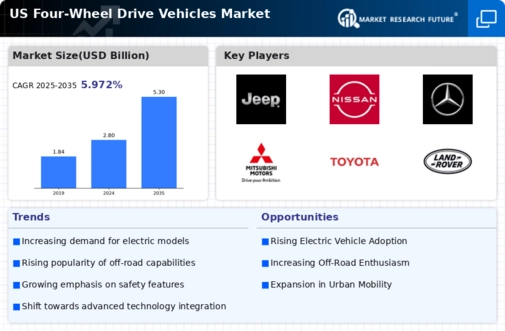Rising Popularity of Outdoor Activities
The increasing interest in outdoor activities among consumers appears to be a significant driver for the four wheel-drive-vehicles market. As more individuals engage in recreational pursuits such as camping, hiking, and off-roading, the demand for vehicles that can navigate rugged terrains is likely to rise. Data indicates that approximately 40% of Americans participate in outdoor activities, which correlates with a growing preference for four wheel-drive vehicles. This trend suggests that manufacturers may need to focus on producing models that cater to this adventurous demographic, potentially leading to innovations in design and functionality. The four wheel-drive-vehicles market could see a substantial boost as consumers seek vehicles that enhance their outdoor experiences.
Increased Focus on Vehicle Customization
The trend towards vehicle customization is becoming increasingly relevant in the four wheel-drive-vehicles market. Consumers are seeking vehicles that reflect their personal style and meet specific needs, such as off-road capabilities or enhanced performance features. This desire for customization may lead to a rise in aftermarket modifications and accessories, which could further stimulate market growth. Data suggests that nearly 30% of four wheel-drive vehicle owners invest in aftermarket products, indicating a robust market for customization. As manufacturers recognize this trend, they may introduce more customizable options, thereby attracting a broader customer base and enhancing the overall appeal of the four wheel-drive-vehicles market.
Urbanization and Infrastructure Development
Urbanization trends in the United States are influencing the four wheel-drive-vehicles market. As cities expand and infrastructure develops, the need for versatile vehicles that can handle both urban and rural environments becomes apparent. The rise in suburban living, where access to outdoor spaces is more prevalent, may drive consumers towards four wheel-drive vehicles. Reports indicate that suburban areas are experiencing a population growth of around 15% annually, which could lead to increased sales in this segment. Furthermore, the four wheel-drive-vehicles market may benefit from the demand for vehicles that can navigate diverse terrains, appealing to both urban dwellers and outdoor enthusiasts alike.
Economic Factors Influencing Consumer Spending
Economic conditions play a crucial role in shaping the four wheel-drive-vehicles market. Factors such as disposable income, fuel prices, and overall economic stability can significantly impact consumer purchasing behavior. As the economy shows signs of recovery, consumer confidence is likely to rise, potentially leading to increased spending on vehicles. Data indicates that when disposable income rises by 5%, vehicle sales tend to increase by approximately 3%. This correlation suggests that a favorable economic environment could bolster the four wheel-drive-vehicles market, as consumers may be more willing to invest in vehicles that offer both utility and leisure.
Growing Interest in Advanced Technology Integration
The integration of advanced technology in vehicles is a notable driver for the four wheel-drive-vehicles market. Consumers are increasingly interested in features such as connectivity, navigation systems, and driver-assistance technologies. The demand for smart vehicles that offer enhanced safety and convenience is likely to shape purchasing decisions. Recent surveys indicate that over 50% of potential buyers prioritize technology features when selecting a vehicle. This trend suggests that manufacturers in the four wheel-drive-vehicles market may need to invest in research and development to incorporate cutting-edge technologies, thereby meeting consumer expectations and remaining competitive in a rapidly evolving market.


























Leave a Comment